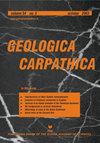The Upper Cretaceous intrusive rocks with extensive crustal contribution in Hacımahmutuşağı Area (Aksaray/Turkey)
IF 1.5
4区 地球科学
Q4 GEOSCIENCES, MULTIDISCIPLINARY
引用次数: 3
Abstract
Abstract The Hacımahmutuşağı area (Aksaray/Turkey) is located in the western part of the Central Anatolian Crystalline Complex (CACC). Gneiss and marble compose the basement units, while intrusive rocks are gabbros and granitoids. The pegmatitic hornblende gabbros contain pegmatitic to fine-grained hornblendes, plagioclase, clinopyroxene, and accessory opaque minerals. The fine-grained gabbros, on the other hand, are composed of plagioclase, hornblende, and biotite as major components whereas the apatite and opaque minerals are present in accessory content. Granitic– granodioritic rocks are the common intrusive rock types in the area, and constitute quartz, orthoclase, plagioclase and biotite, and accessory zircon and opaque minerals. Leucogranites, comprising quartz, orthoclase, plagioclase with minor biotite, hornblende, and with accessory apatite and opaque minerals, are found as dykes intruding the marble and the granitic–granodioritic rocks. Strontium–neodymium isotope data of gabbros and granitoids have high 87Sr/86Sr(i) ratios (0.7076 to 0.7117) and low ɛNd(i) values (−5.0 to −9.8) point out enriched source and pronounced crustal contribution in their genesis. In the Hacımahmutuşağı area, it is plausible that the heat increase caused by the hot zone, which was generated by underplating mafic magma along with the hydrous mafic sills in the lower crust, might have resulted in partial melts from crystallized mafic sills and older crustal rocks. It can be suggested that these hybrid melts adiabatically rose to the shallow crust, ponded and crystallized there and formed the magma source of the intrusive rocks within the Hacımahmutuşağı area and the other hybrid granitic rocks with crustal signatures in the CACC. Geochemical data indicate that granitoids and gabbros are collision to post-collision related sub-alkaline rocks derived from an enriched source with extensive crustal inputs.Hacımahmutuşağı地区(土耳其Aksaray)上白垩统具有广泛地壳贡献的侵入岩
Hacımahmutuşağı地区(Aksaray/土耳其)位于中部安纳托利亚晶体复合体(CACC)的西部。基底单元为片麻岩和大理岩,侵入岩为辉长岩和花岗岩。伟晶质角闪石辉长岩含有伟晶质至细粒角闪石、斜长石、斜辉石及其附属不透明矿物。细粒辉长岩以斜长石、角闪石和黑云母为主,磷灰石和不透明矿物为辅。花岗-花岗闪长岩是该区常见的侵入岩类型,由石英、正长石、斜长石、黑云母等组成,并伴有锆石和不透明矿物。白花岗岩体由石英、正长石、斜长石和少量黑云母、角闪石组成,并伴有磷灰石和不透明矿物,为侵入大理岩和花岗花岗闪长岩的岩脉。辉长岩和花岗岩类具有高87Sr/86Sr(i)比值(0.7076 ~ 0.7117)和低Nd(i)比值(- 5.0 ~ - 9.8)的锶-钕同位素数据,表明其来源丰富,地壳对其成因有明显贡献。在Hacımahmutuşağı地区,基底基性岩浆与下地壳含水基性岩形成的热区引起的热量增加可能导致基性岩结晶与较老的地壳岩石部分熔融。这些混合熔体绝热上升至浅层地壳,在浅层地壳中沉淀结晶,形成了Hacımahmutuşağı地区侵入岩和CACC其他具有地壳特征的混合花岗质岩石的岩浆源。地球化学资料表明,花岗岩类和辉长岩是与碰撞和碰撞后相关的亚碱性岩石,其来源丰富,具有广泛的地壳输入。
本文章由计算机程序翻译,如有差异,请以英文原文为准。
求助全文
约1分钟内获得全文
求助全文
来源期刊

Geologica Carpathica
地学-地球科学综合
CiteScore
2.40
自引率
23.10%
发文量
26
审稿时长
>12 weeks
期刊介绍:
GEOLOGICA CARPATHICA covers a wide spectrum of geological disciplines including geodynamics, tectonics and structural geology, volcanology, stratigraphy, geochronology and isotopic geology, karstology, geochemistry, mineralogy, petrology, lithology and sedimentology, paleogeography, paleoecology, paleobiology and paleontology, paleomagnetism, magnetostratigraphy and other branches of applied geophysics, economic and environmental geology, experimental and theoretical geoscientific studies. Geologica Carpathica , with its 60 year old tradition, presents high-quality research papers devoted to all aspects not only of the Alpine-Carpathian-Balkanian geoscience but also with adjacent regions originated from the Mediterranean Tethys and its continental foreland. Geologica Carpathica is an Official Journal of the Carpathian-Balkan Geological Association.
 求助内容:
求助内容: 应助结果提醒方式:
应助结果提醒方式:


